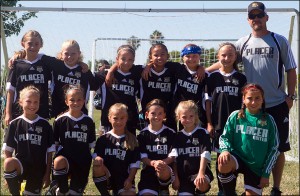Placer United Soccer Club is pleased to announce six new coaches. The Club continues to select dedicated professionals to enhance our amazingly talented staff. The Placer United coaching team is the most highly credentialed in the area, boasting two ‘A’, nine ‘B’ and four ‘C’ USSF licensed coaches. Placer United coaching staff are encouraged to continue their coaching education and coaching experience, which ultimately benefits our players.
New Additions
Bart Morefield – USSF National ‘B’ License
Bart has previously coached with Placer United for over eight years and also served as the Director of Coaching. In addition to his club coaching experience, Bart has coached at Yuba College, various high school varsity programs, CYSA ODP and is a CYSA Staff Instructor. Bart continues to work and coach with Steve Sampson, the former U.S. Men’s National Team Coach. We are very fortunate to have Bart back developing our players.
Hugh Payne – UEFA ‘B’ License, NSCAA Advanced National Diploma
Hugh has just arrived on the scene after a long stint in Southern California with the FRAM Soccer Club. Hugh’s expertise in the development of younger players and developing grass roots programs is second to none. In addition to his work with FRAM, Hugh has worked for the LA Galaxy and the Chivas USA in their camp and development programs.
Chris Alcala – USSF National ‘C’ License
Chris is one of the most recognizable coaches among the Sacramento soccer community. He has over 15 years of competitive coaching experience in the region, including a number of years with the Placer United. Chris has coached a number of teams at the high school level in addition to three years as the Sacramento Knights Assistant Coach. Chris is a former CYSA ODP Staff Coach and is the Director of Alcala Soccer Camps.
Rosella Kelly (Guerrero) – NSCAA Advanced Regional Diploma and CYSA ‘E’ License
Rosella is a Sacramento native and had an outstanding playing career before beginning her coaching career. She is a graduate of Notre Dame and has earned a variety of awards and honors: 1995 NCAA National Champion, two time All-American, Big East Player of the Year, ND career and single season leader in scoring and has a gold medal from the 1995 Olympic Festival. Rosella has been a trainer for the Eureka, Roseville and Loomis Soccer Clubs for the past ten years and has made the transition to competitive soccer. She will be a tremendous addition for our players.
Cory Clonce – CYSA E/D and NSCAA National Diploma (2011)
Cory returns to the Placer United coaching staff after four years with 49er United in Auburn. Cory served as an assistant Director for the Auburn Soccer Academy. Cory has coached the River City High School programs for the past four years. Cory is also a teacher at Harriet Eddy Middle School in Elk Grove.
Dennis Belisle – NSCAA Advanced National Diploma , USSF National ‘C’ License , and English FA Preliminary Badge
Dennis is the second brand new coach joining Placer United staff this year. He brings with him over twenty years of coaching experience at the youth soccer level, not only in the U.S., but Europe and South America as well. He has coached at the collegiate and high school levels and has been an ODP Coach and Directorof Coaching for the Napa Youth Soccer Club and the Sumitt 7000 Soccer Club. He has also worked as the Editor for Goal International Magazine.
Welcome from the entire Placer United Soccer Club!


